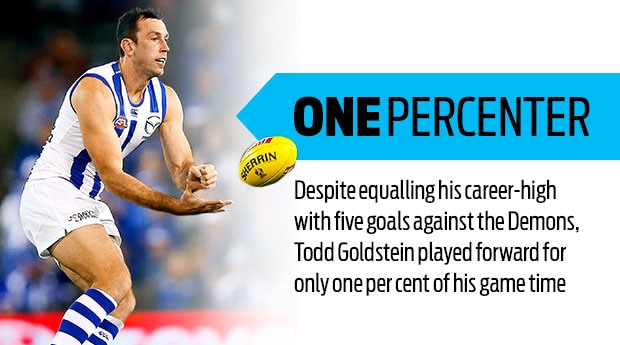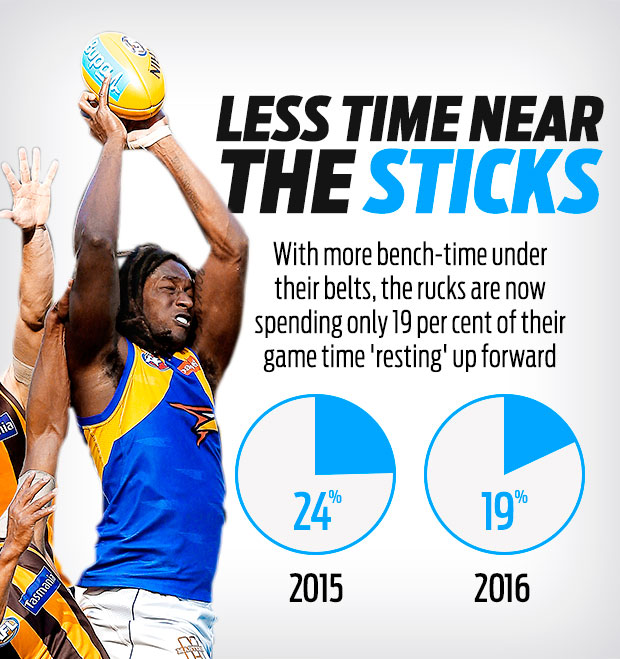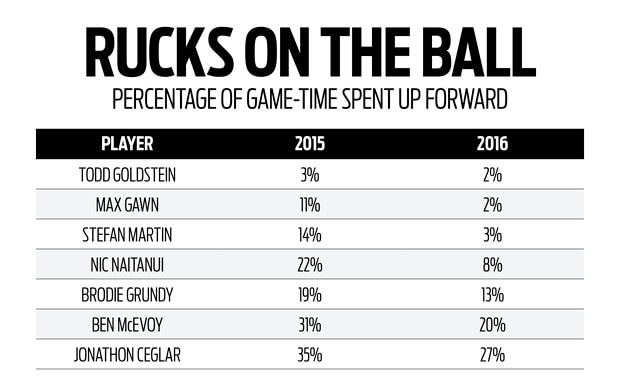
Even by his lofty standards, Todd Goldstein's five-goal haul against Melbourne was a remarkable performance, especially considering the North Melbourne star played only 1 per cent of his total game time in attack.
Although it was a special feat unlikely to be repeated by a full-time ruckman again this season, if the early rounds are a guide we can expect to see ruckmen kicking more goals, more often.

But go back to the pre-season commentary and you'll see things weren’t supposed to happen this way.
The popular pre-season narrative when the cap on interchange rotations was slashed from 120 to 90 was that the League's big men would have to spend more time resting forward to get a breather.
Even the players themselves believed it.
"Obviously (with rotations) being cut by so much, we'll have to play a fair majority of the game on the field," West Coast star Nic Naitanui said in February.
"Just being able to have your rest up forward rather than on the bench, it's better for the players and better for the spectators. So we really look forward to it."
However, stats reveal a different trend three rounds into the season.
Rather than resting forward, ruckmen are actually spending more time on the bench and more game-time in their primary roles – as ruckmen.

Across the competition, the League's big men have played 81 per cent of their game time in the middle, a 5 per cent boost from last season.
And it seems Goldstein – who plays almost exclusively in the ruck – has been ahead of the curve, with his peers playing catch-up.

Naitanui has played 91 per cent of his minutes in the middle this season (+13 per cent from 2015) and 'rested' forward for just 8 per cent of his game time.
Melbourne giant Max Gawn has boosted his ruck minutes to 98 per cent (+9) and Brisbane Lions gun Stefan Martin (+11) is also running almost exclusively through midfield.
Even Hawthorn duo Ben McEvoy (+11) and Jonathon Ceglar (+8) are both spending more of their minutes in the engine room.
It was always going to be a wait-and-see exercise to judge how coaches would alter their strategies to cope with the reduced interchange cap.
So far it seems their all-important big men are being given longer breathers on the bench, but then being asked to spend more time around the ball and to push deeper forward to have an impact.
Ruckmen are kicking more goals (0.7 per game, up from 0.4 last year), taking more marks inside 50 (0.7 up from 0.4) and getting involved in more scoring chains (five goals per game, up one goal).

In round three, we saw some of the game's elite ruckmen at their attacking best.
Incredibly, Gawn nearly pinched the honours in his duel against Goldstein with two majors and 63 hit-outs – including 25 to advantage, the second-most in history according to Champion Data's tracking.
In a thriller at Etihad Stadium, McEvoy kicked two crucial goals as the Hawks surged to victory over the Western Bulldogs, while Ceglar also chipped in with an important goal in the frantic final term.
Meanwhile in Sydney's crosstown battle, Swans big men Kurt Tippett (two goals, 32 hit-outs, four marks inside 50) and Callum Sinclair (one goal), and Giants beast Shane Mumford (one goal) had a big say in a bruising arm-wrestle of a contest.
However, on Sunday Goldstein topped them all and showcased why he's the competition benchmark with five goals and two behinds, 38 hit-outs, nine clearances and two marks inside 50.
Goldy goals and the Roos trail by just one-point! #AFLNorthFreo http://t.co/DSaPNOim2l
— AFL (@AFL) August 23, 2015
With seven goals already this season, he's only four shy of his tally for the entirety of his 2015 All Australian campaign, and six back from his career-best 13 in a season.
The AFL's undisputed No.1 ruckmen is only getting better and influencing matches more on the scoreboard.
And the rest still have some catching up to do.


